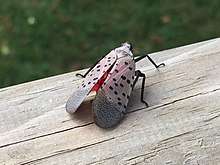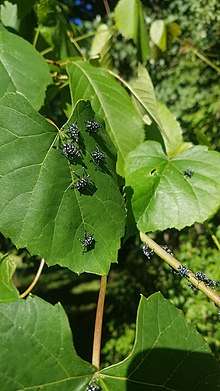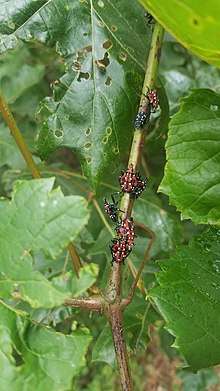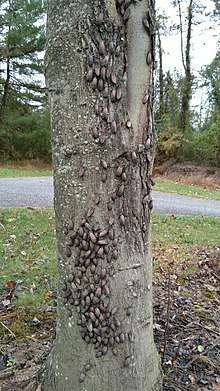Spotted lanternfly
The spotted lanternfly (Lycorma delicatula) is a planthopper that is indigenous to parts of northern China, Taiwan, and Vietnam, and has spread invasively to Japan and South Korea. Although it has two pairs of wings, it jumps more than it flies. Its host plants include grapes, stone fruits, and Malus species, although its preferred host is Ailanthus altissima (Chinese sumac or tree of heaven).[1] In its native habitat it is kept in check by natural predators or pathogens. It was accidentally introduced in South Korea in 2006 and has since been considered a pest. In September 2014, it was first recorded in the United States,[2] and as of 2018 it is an invasive species in eastern Pennsylvania, southwestern New Jersey, northern Delaware, northern Virginia, and eastern Maryland.[3]
| Spotted lanternfly | |
|---|---|
 | |
| Scientific classification | |
| Kingdom: | Animalia |
| Phylum: | Arthropoda |
| Class: | Insecta |
| Order: | Hemiptera |
| Infraorder: | Fulgoromorpha |
| Superfamily: | Fulgoroidea |
| Family: | Fulgoridae |
| Subfamily: | Aphaeninae |
| Genus: | Lycorma |
| Species: | L. delicatula |
| Binomial name | |
| Lycorma delicatula (White, 1845) | |
Description
The spotted lanternfly is originally native to parts of China, India, Vietnam, and eastern Asia.[4] It is a planthopper, belonging to the subfamily Aphaeninae and is approximately 25 mm long and 12 mm wide. It was first described by Adam White in 1845 as Aphaena delicatula with habitat outside of Nankin, China.[5] Adult lanternflies have a black head and gray-brown forewings adorned with the eponymous black spots. When resting, the crimson hindwings are partially visible through the semi-translucent forewings, giving the lanternfly a red cast. Neatly spaced black rectangular markings color the tips of the forewings in a pattern sometimes likened to brick and mortar. In flight, the spotted lanternfly displays red hind wings with black spots on the proximal third, a white wedge in the middle of the wing, and a solid black wing tip. The abdomen is yellowish with black and white bands on the top and bottom.[6] The lanternfly is a strong jumper and uses its wings to assist these jumps rather than making sustained flights.[7] In traditional Chinese medicine, the spotted lanternfly is believed to be poisonous, and is used topically for relief from swelling.[8]
Subspecies
Fulgoromorpha Lists On the Web[9] lists three subspecies:
- Lycorma delicatula delicatula (White, 1845)
- Lycorma delicatula jole Stål, 1863
- Lycorma delicatula operosa (Walker, 1858)
Host associations
A. altissima is a tree which is native to China and invasive to many other areas worldwide; it is considered to be the key host for L. delicatula and plays an important role in the lanternfly life cycle.[10][11] This tree is the preferred host at all documented locations the lanternfly and A. altissima co-occur.[12] However, the spotted lanternfly has a wide host range of over 70 plant species, including grape vines, fruit trees, ornamental trees, and woody trees, including apples and several Rosaceae with stone fruits.[8] This range can include many agricultural crops and common forest plants, as the nymphs have been known to associate with other plants beyond Ailanthus altissima.[12] The lanternfly has been recorded causing serious damage on at least 12 ornamental plants such as Parthenocissus quinquefolia, Phellodendron amurense, and Toona sinensis. In the USA high populations are seen infesting common forest trees, such as maple or birch; in Pennsylvania alone, L. delicatula has been found on more than 20 newly-recorded host species of woody plants.[12]
Life cycle



L. delicatula feeds on woody and non-woody plants, piercing the phloem tissue of foliage and young stems with specialized mouthparts, and sucking the sap;[8] it does not eat the fruit or the leaves per se.[7] The sugary waste fluid they produce coats leaves and stems, and this can encourage mold growth.[4] Beginning in late April to early May, nymphs hatch from their egg cases. A nymph passes through several immature stages, called instars, all of which are wingless. In the first instar it is black with white spots. Later instars have red patches in addition to the white spots. The final nymphal instar has red wing pads and a red upper body, before molting to the adult form, with a black head and grayish wings with black spots.[8] Nymphs hop or crawl to search for plants to feed on.[6] Young nymphs (first through third instars) appear to have a wider host range early on, which narrows as they grow older.[8][13] Even though lanternflies have been recorded feeding on several herbaceous plants, this is most likely due to early instar nymphs climbing or falling onto these plants because late instar nymphs and adult lanternflies have no reliable association with herbaceous plants.[12] As early as July, adults can be seen, and they mate and lay eggs from late September through the onset of winter. In their native Indomalayan habitat they will lay their eggs preferably on tree of heaven (Ailanthus altissima), which has toxic metabolites, and is an introduced invasive tree in North America. This host choice is thought to have evolved as a mechanism of protection from natural enemies.[8] It is unclear whether the lanternfly can complete its life cycle on any host other than A. altissima, and there are further experiments planned in the US. There are many hypotheses as to why L. delicatula may have preferences for feeding on certain plants. Two examples of possible factors being investigated are the contribution of the overall sugar composition in the plant[14] and the presence of toxic chemicals.[13] The lanternfly will lay eggs upon any smooth-trunked tree, stone, or vertical smooth surface, including man-made items like vehicles, yard furniture, farm equipment or other items stored outside.[6] The egg masses contain 30–50 eggs[15] covered in a yellowish brown waxy deposit, often referred to as an egg case.[8] The lanternfly's life expectancy is one year.[8]
Some researchers believe that a severe cold interval is required for the eggs to develop past a certain point, however this has not yet been confirmed.[12] Testing has been done to determine how overwintering affects the eggs of the species. The minimum temperature that will kill eggs was estimated by South Korean researchers to be between −12.7 and −3.4°C (9.1 and 25.9°F) on the basis of mean daily temperatures during their winter of 2009/2010.[16] This estimate contrasts with eggs having survived the much colder winter 2013/14 temperatures in Pennsylvania, United States.[17] Another study done in South Korea suggested that -25°C is about the temperature in which no eggs are hatched, while 15°C still had limited hatching, depending upon how long they were chilled and where they were kept.[18]
Host plant signs of infestation
L. delicatula damages plants directly due to feeding on the sap from the trunk or branches; substantial damage can occur when many insects concurrently feed on the same plant and can present as the senescence of the branches or whole plant.[19] An example of indirect damage is the formation of honeydew as sap collects on their trunks as it weeps from the wounds; this accumulation of sap can attract ants, bees, hornets, and paper wasps to feed on the sap.[6] This fosters the growth of molds on the sap as it collects at the base of the plant, which results in a reduction of photosynthetic potential of the plant, even resulting in the death of the plant.[12][8]
Pathway for entry
L. delicatula will normally use A. altissima for feeding and laying their eggs, but if A. altissima is not present, they can lay their eggs on any stationary object, both manmade and natural, and will feed on a wide variety of plants. While eggs, they can easily be moved from place to place without being noticed, giving them an easy way to spread to new areas. Its initial introduction to the United States is believed to be through this pathway, hitchhiking off of an object imported from Asia into Pennsylvania. When adults, L. delicatula fly around the area to find new host plants, but generally will not thrive unless A. altissima is present. As nymphs, they feed on whatever host plant the egg was laid on before moving to another in the area. It is still uncertain if L. delicatula requires A. altissima to complete their life cycle or if they could finish development on a less desirable host; laboratory studies suggest that adults have trouble surviving off plants other than A. altissima.[14]
Accidental introduction
In South Korea
In 2006, the spotted lanternfly was accidentally introduced in Korea, and has been considered a pest since about 2007. It has since expanded its host range, attacking at least 65 plant species, uninhibited by a natural enemy.[7] The distribution of L. delicatula has since been predicted using a modeling approach, which showed that this pest had the potential to occur in the majority of South Korea.[20] Furthermore, there seems to be a possible correlation between the widespread distribution of A. altissima and the overall damage on grapevines as the tree is commonly found growing on the peripheries of Korean vineyards.[12] L. delicatula has been documented to be a pest to grapevines, leading to a decline in the total number and overall quality of the harvested grapes. There are no quantitative data published supporting this correlation but has been widely hypothesized.[21][12]
In the United States
The spotted lanternfly was first detected in the United States in Berks County, northwest of Philadelphia, Pennsylvania. On September 29, 2014, the Pennsylvania Department of Agriculture and the Pennsylvania Game Commission confirmed its presence. Based on its host affinities, it presented a threat to the state's grape, fruit tree, and logging industries. The greatest risk of spread was seen in people transporting materials containing egg masses laid on smooth bark, stone, and other vertical surfaces,[6] so the Pennsylvania Department of Agriculture banned transport of items that could harbor the hopper, including firewood, lawn mowers, outdoor chairs, trucks, and RVs, from seven municipalities on November 1, 2014.[6] Given the presence of old egg masses, the insect was estimated to have been in the area since at least 2012, having survived the 2013/14 winter's unusual cold.[17] A national working group led by the U.S. Department of Agriculture, consisting of university and USDA scientists, was organized "to determine what is known about the lanternfly and what research is needed, including DNA analysis to pinpoint where the infestation originated."[7]
In July 2018, spotted lanternfly was confirmed in three New Jersey counties.[22] In September 2018 it was found in two New York locations,[23] as well as in Virginia.[24] On February 28, 2019, the Delaware Department of Agriculture signed Emergency Regulations for spotted lanternfly enacting a quarantine for this pest.[25]
Possible pest control
The Pennsylvania Department of Agriculture has been recommending based on information from PennState Extension:[26]
- Kill eggs October through May by scraping them off of surfaces, "double bag them and throw them in the garbage,"[6] or scrape the eggs directly into a Ziploc bag of alcohol or hand sanitizer to kill them.[26]
- Remove spotted lanternfly hosts, the tree Ailanthus altissima (Chinese sumac or tree of heaven), saving only male trees to use as "trap" trees, since the spotted lanternfly requires a meal from this tree before laying eggs.[1] Remaining male "trap" trees should be wrapped with sticky bands starting in early spring to catch any nymphs.
- Trees can be treated with systemic pesticides June–August. The Pennsylvania Department of Agriculture recommends tree injection and bark sprays, applied by professional applicators, and soil drench and foliar sprays, which can be applied by homeowners.[1]
As of 2020 the PDA recommended different pesticides include insecticidal soaps, neem oil, pyrethrins and Essential oils as well as bifenthrin, carbaryl, dinotefuran as bark sprays, imidacloprid, spinosad, tebuconazole, and zeta-cypermethrin.[1]
Sticky traps at the base of tree trunks have also been used.[12] In Pennsylvania, brown sticky traps have been effective at capturing nymphs, though adults may be strong enough to escape the adhesive.[12] Studies have shown that the brown sticky traps are more effective than blue and yellow sticky traps.[27] Also, L. delicatula has been found to be attracted to certain kairomones released by their host plants, and adults and second-to-fourth-instar nymphs also appear to be attracted to spearmint oil. It is hypothesized that such chemicals can be used to lure them into sticky traps to augment this pest control method.[28]
In 2019, researchers from the Hajek Lab at Cornell University have found that two native fungi, Beauveria bassiana and Batkoa major, kill spotted lanternflies,[29][30] and Beauveria bassiana has also shown an ability to kill spotted lanternflies in biopesticide trials.[31]
A few natural predators have been identified in the lanternfly’s native habitat in China, but are not yet used in biocontrol. The most notable one being tested is the eupelmid wasp Anastatus orientalis, due to its high rates of parasitism of eggs; it is being investigated in the Republic of Korea[32] and in the United States where they are being evaluated under quarantine until researchers are certain they themselves won't become an invasive species and attack other insects.[33]
See also
References
- Leach, Heather; Biddinger, David; Krawczyk, Greg; Swackhamer, Emelie; Korman, Amy; Walsh, Brian (8 May 2020). "Spotted Lanternfly Management for Homeowners". PennState Extension. Retrieved 22 June 2020.
- Montague, Zach (2018-05-21). "Lanternflies Eat Everything in Sight. The U.S. Is Looking Delicious". The New York Times. ISSN 0362-4331. Retrieved 2020-01-13.
- "First Spotted Lanternfly Confirmed in Maryland". 2018-10-25. Retrieved 2020-01-13.
- Bill Chapell (3 November 2014). "Invasive Bug Prompts Quarantine In Pennsylvania Townships". The Two Way Breaking News from NPR.org. NPR.org.
- Adam White (1845). "Descriptions of a new genus and some new species of homopterous insects from the East in the collection of the British Museum". Annals and Magazine of Natural History. Biodiversity Heritage Library. 15 (95): 34–37. doi:10.1080/037454809495244.
- "Spotted Lanternfly". Pennsylvania Department of Agriculture. n.d.
- Chuck Gill (17 November 2014). "Entomologists hope vigilance, research stop newly discovered spotted lanternfly". phys.org. Science X network.
- Western Farm Press (10 November 2014). "Spotted lanternfly - a new threat to grapes, stone fruit?". Western Farm Press. Penton Agriculture Market.
- Bourgoin T: Fulgoromorpha Lists On the Web (FLOW): Lycorma delicatula (White, 1845) (retrieved 26 April 2020)
- Barringer, Lawrence E.; Donovall, Leo R.; Spichiger, Sven-Erik; Lynch, Daniel; Henry, David (June 2015). "The First New World Record ofLycorma delicatula(Insecta: Hemiptera: Fulgoridae)". Entomological News. 125 (1): 20–23. doi:10.3157/021.125.0105. ISSN 0013-872X.
- Park, JI-Doo; Kim, Min-Young; Lee, Sang-Gil; Shin, Sang-Chul; Kim, Jun-Heon; Park, Il-Kwon (2009-03-30). "Biological Characteristics of Lycorma delicatula and the Control Effects of Some Insecticides". Korean Journal of Applied Entomology. 48 (1): 53–57. doi:10.5656/ksae.2009.48.1.053. ISSN 1225-0171.
- "EPPO activities on PRA". https. Retrieved 2020-02-19.
- Kim, Jae Geun; Lee, Eun-Hyuk; Seo, Yeo-Min; Kim, Na-Yeon (2011-06-08). "Cyclic behavior of Lycorma delicatula (Insecta: Hemiptera: Fulgoridae) on host plants". Journal of Insect Behavior. 24 (6): 423–435. doi:10.1007/s10905-011-9266-8. ISSN 0892-7553.
- Lee, Jeong-Eun; Moon, Sang-Rae; Ahn, Hee-Geun; Cho, Sun-Ran; Yang, Jeong-Oh; Yoon, Chang-Mann; Kim, Gil-Hah (2009-12-30). "Feeding behavior of Lycorma delicatula (Hemiptera: Fulgoridae) and response on feeding stimulants of some plants". Korean Journal of Applied Entomology. 48 (4): 467–477. doi:10.5656/ksae.2009.48.4.467. ISSN 1225-0171.
- Department of Entomology (10 November 2014). "The spotted lanternfly, a new insect pest detected in Pennsylvania". Entomology News 2014. Penn State's College of Agricultural Sciences.
- Lee, Jung-Su; Kim, Il-Kwon; Koh, Sang-Hyun; Cho, Sung Jong; Jang, Suk-Jun; Pyo, Seung-Hyeon; Choi, Won IL (January 2011). "Impact of minimum winter temperature on Lycorma delicatula (Hemiptera: Fulgoridae) egg mortality". Journal of Asia-Pacific Entomology. 14 (1): 123–125. doi:10.1016/j.aspen.2010.09.004.
- Maher, Kris (18 November 2014). "New Invasive Pest Has Pennsylvania Towns on Alert". The Wall Street Journal. Retrieved 5 October 2019.
- Park, JI-Doo; Kim, Min-Young; Lee, Sang-Gil; Shin, Sang-Chul; Kim, Jun-Heon; Park, Il-Kwon (2009-03-30). "Biological characteristics of Lycorma delicatula and the control effects of some insecticides". Korean Journal of Applied Entomology. 48 (1): 53–57. doi:10.5656/ksae.2009.48.1.053. ISSN 1225-0171.
- Barringer, Lawrence (2016). "Spotted lanternfly, Lycorma delicatula (Hemiptera: Fulgoridae)". 2016 International Congress of Entomology. Entomological Society of America. doi:10.1603/ice.2016.92745.
- Jung, Jae-Min; Jung, Sunghoon; Byeon, Dae-hyeon; Lee, Wang-Hee (December 2017). "Model-based prediction of potential distribution of the invasive insect pest, spotted lanternfly Lycorma delicatula (Hemiptera: Fulgoridae), by using CLIMEX". Journal of Asia-Pacific Biodiversity. 10 (4): 532–538. doi:10.1016/j.japb.2017.07.001. ISSN 2287-884X.
- Kim, Hyojoong; Kim, Minyoung; Kwon, Deok Ho; Park, Sangwook; Lee, Yerim; Huang, Junhao; Kai, Shi; Lee, Heung-Sik; Hong, Ki-Jeong; Jang, Yikweon; Lee, Seunghwan (December 2013). "Molecular comparison of Lycorma delicatula (Hemiptera: Fulgoridae) isolates in Korea, China, and Japan". Journal of Asia-Pacific Entomology. 16 (4): 503–506. doi:10.1016/j.aspen.2013.07.003. ISSN 1226-8615.
- Warren, Michael (January 30, 2019). "These three N.J. counties are now under a spotted lanternfly quarantine". nj.com. Retrieved 5 October 2019.
- Orr, Steve; Schuhmacher, Tracy (11 September 2018). "Invasive bug that feasts on grapes, hops and apples found in the Finger Lakes". Democrat and Chronicle. Retrieved 12 September 2018.
- McGrath, Mike (5 October 2018). "Invasive spotted lanternfly makes journey into Virginia". WTOP. Retrieved 5 October 2018.
- "Spotted Lanternfly". Delaware Department of Agriculture. Retrieved 5 October 2019.
- Swackhamer, Emelie. "Extension Educator, Green Industry". Penn State Extension. Penn State Extension. Retrieved 3 September 2017.
- Choi, Duck-Soo; Kim, Do-Ik; Ko, Suk-Ju; Kang, Beom-Ryong; Park, Jong-Dae; Kim, Seon-Gon; Choi, Kyeong-Ju (2012-12-01). "Environmentally-friendly control methods and forecasting the hatching time Lycorma delicatula (Hemiptera: Fulgoridae) in Jeonnam Province". Korean Journal of Applied Entomology. 51 (4): 371–376. doi:10.5656/ksae.2012.09.0.022. ISSN 1225-0171.
- Cooperband, Miriam F.; Wickham, Jacob; Cleary, Kaitlin; Spichiger, Sven-Erik; Zhang, Longwa; Baker, John; Canlas, Isaiah; Derstine, Nathan; Carrillo, Daniel (2019-03-21). "Discovery of three kairomones in relation to trap and lure development for spotted lanternfly (Hemiptera: Fulgoridae)". Journal of Economic Entomology. 112 (2): 671–682. doi:10.1093/jee/toy412. ISSN 0022-0493. PMID 30753676.
- "Destructive plant pest thwarted by two native fungi". Cornell Chronicle. Retrieved 2019-10-06.
- Clifton, Eric H.; Castrillo, Louela A.; Gryganskyi, Andrii; Hajek, Ann E. (2019-05-07). "A pair of native fungal pathogens drives decline of a new invasive herbivore". Proceedings of the National Academy of Sciences. 116 (19): 9178–9180. doi:10.1073/pnas.1903579116. ISSN 0027-8424. PMC 6511058. PMID 31010927.
- Buffone, John (August 30, 2019). "There's fungus among us, and it might kill off the spotted lanternfly in Pa". York Daily Record. USA Today Network. Retrieved September 10, 2019.
- Choi, Man-Young; Yang, Zhong-Qi; Wang, Xiao-Yi; Tang, Yan-Long; Hou, Zhen-Rong; Kim, Jeong Hwan; Byeon, Young Woong (2014-06-01). "Parasitism rate of egg parasitoid Anastatus orientalis (Hymenoptera: Eupelmidae) on Lycorma delicatula (Hemiptera: Fulgoridae) in China". Korean Journal of Applied Entomology. 53 (2): 135–139. doi:10.5656/ksae.2014.01.1.075. ISSN 1225-0171.
- Charles, Dan (16 September 2019). "Vineyards Facing An Insect Invasion May Turn To Aliens For Help" (Radio broadcast episode). npr. Retrieved 20 February 2020.
External links
- Hungry Pests Campaign - Spotted Lanternfly, United States Department of Agriculture
- Species Profile - Spotted Lanternfly (Lycorma delicatula), National Invasive Species Information Center, United States National Agricultural Library.
- Pennsylvania Department of Agriculture spotted lanternfly information page.
- PennState Extension spotted lantern information page.